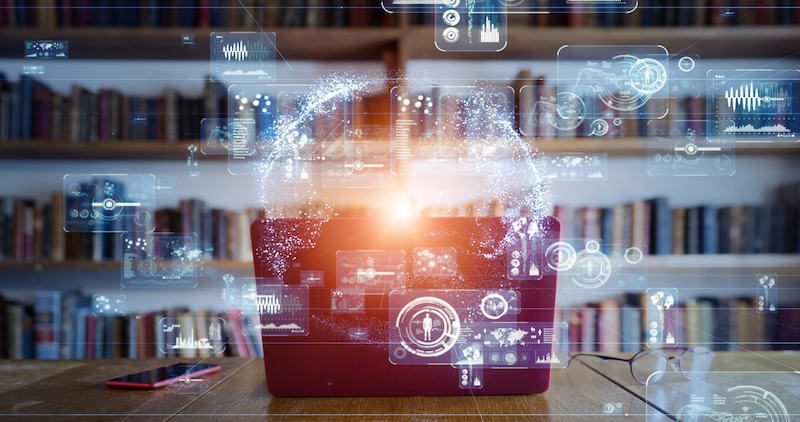Artificial intelligence (AI) has rapidly transformed from a futuristic concept to an integral part of our daily lives, and education is no exception. In 2024, AI technologies are revolutionizing the academic landscape, offering unprecedented opportunities for personalized learning, administrative efficiency and improved educational outcomes. From intelligent tutoring systems to AI-driven classroom management, the impact of AI is profound and far-reaching.
Educators and administrators can now leverage AI to analyze vast amounts of data, providing insights that drive informed decisions and strategies. Additionally, AI is breaking down education barriers thanks to tools that support students with different needs and learning styles. As AI evolves, its potential to transform education grows, setting the stage for a future where learning is more personalized and effective.
So, exactly how can AI be used in education? Keep reading as we explore the applications and advancements that make AI in teaching beneficial for modern learners.
Learn More: 8 Essential Questions to Ask Before Choosing an AI Master’s Program
9 Benefits of AI in Education
Artificial intelligence is no longer just a promise for the future — it’s actively enhancing education today. By integrating AI into classrooms, educators can personalize learning experiences, streamline administrative tasks and provide more effective support to students. Here are some of the specific benefits AI brings to the education sector:
1. Enhanced Personalized Learning
AI tailors educational content to each student’s unique learning style and pace. For example, platforms like DreamBox and Smart Sparrow analyze student responses in real time to adapt lessons dynamically, enabling every student to master concepts at their own speed.
2. Automated Administrative Tasks
AI automates grading, scheduling and report generation, significantly reducing the workload on educators. Tools like Gradescope provide consistent and objective grading of assignments, while AI scheduling software helps optimize class timetables and resource allocation.
3. More Engaged Learners
AI makes learning more interactive and engaging through gamified content and adaptive learning platforms. Programs like Kahoot! and Minecraft: Education Edition use AI to create interactive quizzes and simulations that respond to student input, keeping learners motivated and involved.
4. Improved Accessibility
AI-driven assistive technologies support students with disabilities, ensuring a more effective learning environment. Speech recognition software like Notta transcribes spoken words into text for hearing-impaired students, and AI-supported educational games provide personalized learning experiences for young children.
5. Actionable Insights
AI analyzes vast amounts of educational data to provide educators with actionable insights. Platforms like Knewton Alta track student performance across various metrics, helping teachers identify learning gaps and adjust their instructional strategies accordingly.
6. More Efficient Classroom Management
AI tools help teachers manage classroom behavior and engagement. For example, Classcraft uses AI to gamify classroom management, tracking student behavior and rewarding positive actions, which helps maintain a productive and motivated classroom environment.
7. Better Security and Assessment Integrity
AI enhances the security and integrity of assessments through advanced proctoring and plagiarism detection. Tools like Turnitin check for originality in student submissions, and AI-supported proctoring systems monitor exam conditions to prevent cheating.
8. Continuous Lifelong Learning and Professional Development
AI supports continuous learning and professional development for educators by recommending personalized resources and courses. Platforms like Edthena provide tailored learning paths based on educators’ career goals and teaching needs.
9. Greater Scalability
AI enables the scaling of educational programs to accommodate more students without compromising quality. AI-based platforms can handle large volumes of data and provide personalized learning experiences to a growing number of learners, ensuring accessibility and consistency in education.
39 Examples of AI in Education
Artificial intelligence is revolutionizing education with cutting-edge tools that enhance teaching and learning. From personalizing experiences to optimizing administrative tasks, here are 39 examples of how AI is transforming modern education:
- Adaptive Learning: AI-driven platforms assess students’ skill levels in real time and tailor instructional content to meet individual needs. These systems adapt lessons dynamically based on student responses, providing customized pathways to help students master concepts at their own pace.
- Assistive Technology: Tools such as speech recognition software transcribe spoken words into text, helping students with disabilities such as hearing impairments or dyslexia to participate more fully in the classroom by converting speech to text and vice versa.
- Data and Learning Analytics: AI helps analyze data from online learning portals, classroom attendance and grades. This data provides insights into student performance, helping educators identify trends and tailor instruction to address gaps in understanding and performance.
- Classroom Management: Platforms use AI to gamify classroom management. AI tracks student behavior and engagement, rewarding positive actions with points and badges and providing teachers with insights into classroom dynamics to manage and motivate students.
- Intelligent Tutoring Systems: AI-powered tutoring systems such as Carnegie Learning provide personalized feedback and support, adapting to individual learning styles and needs to help students understand complex concepts and improve academic performance.
- Automated Grading and Assessment Tools: These tools use AI to evaluate assignments and provide detailed feedback, streamlining the grading process, ensuring consistency and saving teachers time. AI can also grade more abstract assessments like essays by analyzing the content for coherence and relevance.
- Chatbots and Virtual Assistants: AI-driven chatbots such as Mainstay provide students with immediate support and assistance outside classroom hours. These chatbots answer questions, remind students of deadlines and guide them through administrative processes, enhancing engagement and promoting independent learning.
- Curriculum Planning: AI helps educators plan curricula by analyzing educational data to identify trends and gaps. This ensures the curriculum remains relevant, comprehensive and aligned with learning objectives by suggesting updates based on the latest educational needs and standards.
- Interactive and Learning Games: AI enhances educational games by creating engaging and adaptive learning experiences. These games use AI to provide tasks and challenges that adapt to student responses, promoting active participation and understanding of complex subjects.
- Personalized Learning: AI learning platforms create customized learning experiences by adapting to the unique ways students understand concepts. This reduces cognitive load and ensures that each student receives instruction tailored to their learning style and pace.
- Task Automation: AI automates routine tasks such as homework assessment, test grading and report generation. This enables educators to focus on more meaningful instructional activities and student interactions.
- Smart Content Creation: AI aids instructors in the creation of digital lessons and study materials. Tools like Magic School AI and Eduaide.AI simplify lesson planning, create assessments, write individualized education plans (IEPs), and much more to modernize learning and streamline instruction.
- Proctoring: AI-powered proctoring systems monitor exams to prevent cheating and ensure academic integrity. These systems analyze students’ behavior during exams, providing real-time alerts for suspicious activities and maintaining a secure testing environment.
- Language Learning: AI tools like Duolingo use adaptive algorithms to personalize language learning experiences. The AI adjusts the difficulty of exercises based on the user’s progress, ensuring an optimal learning curve and enhancing language acquisition.
- Closing the Skill Gap: AI identifies skill gaps in students by analyzing their performance data and provides targeted resources to address these deficiencies. This helps learners achieve proficiency in various subjects and prepares them for future academic challenges.
- Dyslexia Detection: AI tools such as Dysolve can detect dyslexia and other learning disabilities early on by analyzing reading patterns and errors. These tools provide tailored support and interventions to help affected students succeed, such as specialized reading programs and exercises.
- Edutainment and Gamification: AI integrates game elements into academic content, making learning fun and engaging. Platforms use AI to create interactive quizzes and games that promote deeper understanding and retention of educational material.
- Administrative Support: AI assists in administrative tasks such as scheduling, budgeting and resource allocation. Tools like Fetchy optimize educational operations by providing data-driven insights and recommendations, improving efficiency and reducing workload for educators.
- Virtual 3D Classrooms: The metaverse creates immersive virtual classrooms where students can interact with classmates and teachers. Platforms like Engage VR offer virtual environments that enhance the learning experience beyond traditional methods, providing opportunities for interactive and experiential learning.
- Digital Learning: AI enhances digital classrooms by providing immersive video content and interactive simulations. Tools like Nearpod use AI to deliver engaging and effective learning experiences through interactive lessons and real-time student feedback.
- Virtual Campus Activities: AI facilitates virtual extracurricular activities, allowing students to participate in clubs and events from anywhere in the world. Platforms like Remo use AI to create virtual spaces for networking and collaboration, enhancing student engagement beyond the classroom.
- Interdisciplinary Learning: AI breaks down barriers between subjects, promoting interdisciplinary learning. Tools like Wolfram Alpha use AI to demonstrate real-life applications of various theories, helping students understand the interconnectedness of different fields of study.
- Simulating Real-Life Situations: AI replicates real-life scenarios in virtual environments, allowing students to conduct experiments and learn through practical experience. Platforms like Labster offer virtual labs where students can safely explore and experiment with scientific concepts.
- Building Awareness: AI can teach students about social issues such as climate change and poverty. Tools like EarthSpeakr use AI to provide a deep emotional understanding alongside theoretical knowledge, promoting awareness and action on global challenges.
- Virtual Tours: AI-powered virtual tours enable students to explore different parts of the world from their classrooms. Platforms like Google Expeditions use AI to create immersive virtual field trips, broadening students’ horizons and enhancing their cultural understanding. These can also be useful in facilitating virtual tours of colleges.
- Guest Speakers and Events: AI facilitates virtual events and guest lectures, allowing students to learn from prominent figures and experts in various fields. Tools like BigMarker use AI to organize and manage virtual conferences, enhancing the learning experience through expert insights.
- Predictive Analytics: AI algorithms in learning analytics help educators spot trends and predict student performance, enabling early intervention for students who might struggle.
- Parent-Teacher Communication: AI-powered tools like Remind facilitate seamless communication between parents and teachers, allowing for real-time updates on student progress and classroom activities, thereby enhancing parental engagement and support in the education process.
- Test Prep: AI platforms like Magoosh provide personalized test preparation by analyzing student performance and adapting practice questions and study plans to focus on areas where students need the most improvement, thereby increasing their chances of success.
- Learning Management Systems (LMS): AI enhances LMS platforms by providing personalized learning paths, automating administrative tasks and offering data-driven insights into student performance and engagement.
- Professional Development: AI tools provide personalized professional development opportunities for educators by recommending courses and resources based on their career goals and teaching needs.
- Transportation: AI-powered systems optimize school bus routes, reducing travel time and improving safety. Tools like SafeStop use real-time data to track bus locations and provide parents with accurate arrival times, enhancing the overall efficiency of student transportation.
- Finance: AI assists educational institutions in managing their finances by analyzing spending patterns, predicting future expenses and identifying cost-saving opportunities. Tools like Allovue help schools allocate resources more effectively and improve financial planning.
- Cybersecurity: AI enhances the security of educational institutions by detecting and responding to cyber threats in real time. Tools like Darktrace use machine learning algorithms to identify unusual network activity, prevent data breaches and protect sensitive student information.
- Safety and Security: AI-powered surveillance systems monitor school premises for potential safety threats. Tools like Avigilon use AI to analyze video feeds and alert security personnel to suspicious activities, thereby enhancing the overall safety and security of the school environment.
- Plagiarism Detection: AI tools analyze student submissions for potential plagiarism by comparing them against a vast database of academic content, ensuring academic integrity and originality in student work.
- Enhanced Online Discussion Boards: AI enhances online discussion boards by moderating content, facilitating discussions and providing personalized feedback. Tools like Packback use AI to encourage critical thinking and engagement in online forums, creating a more dynamic and interactive learning environment.
- Academic Research: AI assists academic research by analyzing large datasets, identifying trends and generating insights. Tools like IBM Watson Discovery provide researchers with advanced analytics capabilities, helping them uncover new findings and accelerate the research process.
- Connected Campuses: AI integrates various campus systems to create a connected and efficient educational environment. Tools like Cisco Digital Network Architecture (DNA) use AI to manage and optimize campus infrastructure, enhancing connectivity and improving the overall campus experience.
AI in Education: Universal Access
Bernard Marr explains that AI tools can enhance universal access to education in a number of ways, including:
- Helping to “make global classrooms available to all, including those who speak different languages or who might have visual or hearing impairments”
- Creating access for “students who might not be able to attend school due to illness”
- Better serving “students who require learning at a different level or on a particular subject that isn’t available in their own school”
Overall, it is hoped that AI will ultimately help educators make continued progress in addressing the broad range of physical, cognitive, academic, social and emotional factors that can affect student learning and ensure that all students have equal opportunity in education, regardless of their social class, race, gender, sexuality, ethnic background or physical and mental disabilities.
AI in Education: Individualized Learning
There is also considerable optimism around the idea that, as artificial intelligence becomes a more integral part of the classroom, teachers will be better equipped to offer an individualized learning experience for every student.
According to an article in The Atlantic, (“Artificial Intelligence Promises a Personalized Education for All”), artificial intelligence holds the potential to “enhance human teachers’ abilities to tailor lessons to each student without knocking their class schedule off track,” eliminating the need for educators to “teach to the middle,” as often happens when their students have a range of skill levels and learning abilities.
Rose Luckin, a professor of learning-centered design at University College London, is quoted as saying that, “The real power of artificial intelligence for education is in the way that we can use it to process vast amounts of data about learners, about teachers, about teaching and learning interactions.” Ultimately, AI can “help teachers understand their students more accurately, more effectively.”
The Future of AI in Education
Though there continues to be widespread debate over the pros and cons of deploying AI technology in the field of education, including the concerns about depersonalization and the ethical considerations cited above, there is an emerging consensus that the extraordinary range of current and future benefits will carry the day.
This report on Artificial Intelligence in Education was developed by the University of San Diego’s innovative, online Master of Science in Applied Artificial Intelligence program, an AI industry thought leader and education partner.



